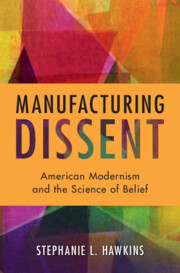Refine search
Actions for selected content:
207 results
2 - Lawmaking, Law Enforcement, and “Legalistic Ethical Reasoning”
- from Part I - Drivers of Change in the World of Cultural Property
-
- Book:
- Cultural Property
- Published online:
- 05 November 2025
- Print publication:
- 30 October 2025, pp 34-102
-
- Chapter
- Export citation

Manufacturing Dissent
- American Modernism and the Science of Belief
-
- Published online:
- 03 October 2025
- Print publication:
- 21 August 2025
13 - Word-Formation
- from Part III - Expanding Features
-
- Book:
- How to Create a Language
- Published online:
- 23 October 2025
- Print publication:
- 02 October 2025, pp 281-304
-
- Chapter
- Export citation
Chapter 6 - Michael Field’s Catholicism
- from Part I - Works and Days
-
-
- Book:
- Michael Field in Context
- Published online:
- 03 October 2025
- Print publication:
- 25 September 2025, pp 48-56
-
- Chapter
- Export citation
Chapter 1 - Staging Consent
-
- Book:
- Manufacturing Dissent
- Published online:
- 03 October 2025
- Print publication:
- 21 August 2025, pp 16-57
-
- Chapter
- Export citation
Introduction
-
- Book:
- Manufacturing Dissent
- Published online:
- 03 October 2025
- Print publication:
- 21 August 2025, pp 1-15
-
- Chapter
- Export citation
9 - Reflections on the Nature of the Lexeme
- from Part I - Basic Questions
-
- Book:
- Reflections on English Word-Formation
- Published online:
- 03 October 2025
- Print publication:
- 07 August 2025, pp 69-74
-
- Chapter
- Export citation
20 - Reflections on the Limits of Conversion
- from Part V - Patterns of Word-Formation in English
-
- Book:
- Reflections on English Word-Formation
- Published online:
- 03 October 2025
- Print publication:
- 07 August 2025, pp 155-163
-
- Chapter
- Export citation
23 - Reflections on the Irregularity of Prepositions
- from Part V - Patterns of Word-Formation in English
-
- Book:
- Reflections on English Word-Formation
- Published online:
- 03 October 2025
- Print publication:
- 07 August 2025, pp 174-178
-
- Chapter
- Export citation
The Epistemic Significance of Mind-Changing
-
- Article
-
- You have access
- Open access
- HTML
- Export citation
The Conversion of Grief in the Confessions
-
- Journal:
- New Blackfriars / Volume 106 / Issue 5 / September 2025
- Published online by Cambridge University Press:
- 18 June 2025, pp. 428-438
- Print publication:
- September 2025
-
- Article
- Export citation
4 - Patrick of Ireland, Confession
- from Part I - Entering the Community
-
-
- Book:
- The Cambridge Edition of Early Christian Writings
- Published online:
- 19 May 2025
- Print publication:
- 12 June 2025, pp 55-70
-
- Chapter
- Export citation
2 - Augustine of Hippo, Confessions 8
- from Part I - Entering the Community
-
-
- Book:
- The Cambridge Edition of Early Christian Writings
- Published online:
- 19 May 2025
- Print publication:
- 12 June 2025, pp 14-38
-
- Chapter
- Export citation
1 - Gregory of Nazianzus, Oration 18.5–17, “Funeral Oration for His Father”
- from Part I - Entering the Community
-
-
- Book:
- The Cambridge Edition of Early Christian Writings
- Published online:
- 19 May 2025
- Print publication:
- 12 June 2025, pp 3-13
-
- Chapter
- Export citation
3 - Augustine of Hippo, Sermon 279, “On Paul the Apostle, for the Solemnity of His Conversion”
- from Part I - Entering the Community
-
-
- Book:
- The Cambridge Edition of Early Christian Writings
- Published online:
- 19 May 2025
- Print publication:
- 12 June 2025, pp 39-54
-
- Chapter
- Export citation
5 - Loving in Conflict
-
- Book:
- Political Theology and the Conflicts of Democracy
- Published online:
- 21 March 2025
- Print publication:
- 03 April 2025, pp 280-326
-
- Chapter
- Export citation
29 - The Medieval Papacy and the Jews
- from Part V - Inter-Faith Relations: Confrontation and Dialogue
-
-
- Book:
- The Cambridge History of the Papacy
- Published online:
- 28 February 2025
- Print publication:
- 20 March 2025, pp 747-769
-
- Chapter
- Export citation
INTERFERENCE TORTS IN THE DIGITAL ASSET WORLD
-
- Journal:
- The Cambridge Law Journal / Volume 84 / Issue 1 / March 2025
- Published online by Cambridge University Press:
- 17 February 2025, pp. 115-142
- Print publication:
- March 2025
-
- Article
-
- You have access
- Open access
- HTML
- Export citation
WHAT WAS THE ACTIO ONERIS AVERSI?
-
- Journal:
- The Cambridge Law Journal / Volume 84 / Issue 1 / March 2025
- Published online by Cambridge University Press:
- 14 February 2025, pp. 79-103
- Print publication:
- March 2025
-
- Article
-
- You have access
- Open access
- HTML
- Export citation
7 - Utility Models in Italy
- from Part I - Utility Model Laws and Practices around the World
-
-
- Book:
- Sub-patent Innovation Rights
- Published online:
- 06 February 2025
- Print publication:
- 13 February 2025, pp 117-128
-
- Chapter
-
- You have access
- Open access
- HTML
- Export citation
